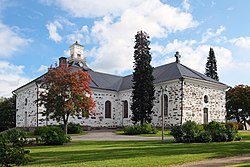You can help expand this article with text translated from the corresponding article in Finnish. (June 2023)Click [show] for important translation instructions.
|
| Kuopio Cathedral Kuopion tuomiokirkko Kuopio domkyrka | |
|---|---|
 Kuopio Cathedral | |
| Religion | |
| Affiliation | Evangelical Lutheran Church of Finland |
| District | Diocese of Kuopio |
| Ecclesiastical or organizational status | Cathedral |
| Location | |
| Location | Vahtivuori, Kuopio, Finland |
 | |
| Geographic coordinates | 62°53′28″N027°41′02″E / 62.89111°N 27.68389°E |
| Architecture | |
| Architect(s) | Pehr W. Palmrooth |
| Type | Cathedral |
| Style | Neoclassical |
| Completed | 1816 |
| Capacity | 1500 seats |
Kuopio Cathedral (Finnish : Kuopion tuomiokirkko, Swedish : Kuopio domkyrka) is a stone Neoclassical-style Evangelical Lutheran church in Kuopio, Finland, and the seat of the Diocese of Kuopio. The cathedral was built between 1806 and 1815. [1] There is a bust of Johan Vilhelm Snellman in the square in front of the cathedral. [2]
Contents
According to George Renwick, during the Finnish War, it was briefly used as a stable by the invaders. [2]

